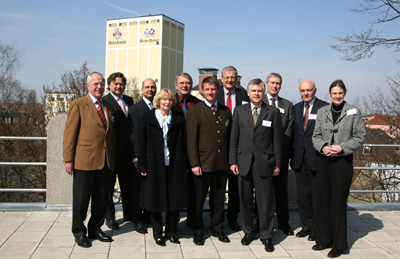Special strains of Gluconobacter, Lactobacillus and Kluyveromyces have been selected for the production of a new beverage on the basis of wort. This beverage contains the health benefiting substances gluconic acid, lactic acid and an ethanol concentration below 0.5 % (v/v). Fermentation was adapted for growth behaviour and to maximise production – the strategy developed concurrently produces (a) gluconic acid by using the strictly aerobic Gluconobacter strain and (b) lactic acid by using the anaerobic strain of Lactobacillus. The concentrations of the simultaneously produced organic acids are controlled by the level of oxygen in the fermentation medium..
The measurement of the malt volatiles targets Maillard-products, Strecker-aldehydes, higher alcohols and compounds of the lipid metabolism of barley. These substances act as indicators for a multiplicity of technological factors, like proteolysis or thermal load during kilning. The effects of using malts with different loads of volatile compounds for beer production will be discussed in Part II of this publication series. This paper shows the improved method of analysis for these substances and the influence of various malting parameters on the formation of the volatile compounds using a statistically planed experimental design termed Response Surface Methodology. If one considers only malts within brewing specifications a factor of up to 7 still remains..
The focal point of this work was to evaluate variations in fermentation-control, which included different fermentation temperatures and different pitching rates, the usage of yeast from various numbers of generations as well as the application of pressure fermentation. Of particular interest was the monitoring of haze relevant polyphenols and proteins as well as the detection of antioxidative capacity, which was differentiated between fast reducing substances and total reducing power. The force tests showed reproducible lower formation of colloidal haze in the beers resulting from fermentation at lower temperatures and from decreasing numbers of yeast generations. Also lower pitching rates and pressure fermentation seem to improve colloidal stability..
According to relevant definitions in literature, drinkability can be divided into a conscious part regarding measurable beer attributes and a subconscious part which contains both social and psychological factors. The fluid flow of beer in the mouth and the resulting mouthfeel can be considered as being an aspect of the conscious and therefore measurable attributes. For this reason, the current study deals with the improving our understanding of the intra-oral fluid flow, visualized by means of numerical simulations and with the resulting sensory sensations which occur during the process of drinking. The aim of the study is to develop a hybrid tool which offers the opportunity to describe and predict mouthfeel only by virtue of the rheological characteristics of beverages and liquid foods.
BrewingScience - Monatsschrift für Brauwissenschaft, 60 (July/August) 2007, pp. 90-95
Nearly any expansion of a process entails chess-like considerations where to add space, what equipment to install, how to arrange it, when will it pay back, and how it will impact the waste stream. But when the plant is located in an extremely remote area, advanced planning and reliable equipment takes on added significance.
For this investigation 63 yeast samples from 25 German breweries have been tested on their viability (methylene blue staining), vitality (measurement of the intracellular pH) and their proteinase A activity in order to get an overview of the situation in breweries. The samples for this investigation were obtained from breweries with production capacities ranging from 50 000 hl up to over 1 million hl.
The participants of the 81st general meeting, which took place on the 26th March 2007 in the German Hop Museum in Wolnzach, approved unanimous the installation of an international advisory board. This board was constituted on the very next day at the Paulaner Brewery in Munich. The initial members of the advisory board are:
Due to their carcinogenic properties the occurrence of nitrosamines in beer raised major concerns in the 1980s. Since then, the production technologies were changed, especially to minimize nitrosamine formation during malt kilning. In this study, our systematic results of nitrosamine analysis between 1992 and 2006 as well as results of a computer-assisted literature review about nitrosamines in beer are reported.
The start-up behaviour of a wort kettle with a steam heated internal reboiler has been investigated using an open, single tube (length 2.3 m, inner diameter 44.3 mm), steam heated natural circulation evaporator. Hereby, the influence of heating steam pressures (0.18 to 0.45 MPa), hydrostatic head H with water for process medium has been evaluated. This work implies the description of appearing operational modes during start-up, the time for the start-up process and the development of parameter constellations for a gentle heating up of the process medium. On the course to a stationary behaviour with saturated boiling at the outlet of the evaporator, different transient and stationary operational modes can arise e.g. The former mode may lead to serious degradation of wort and apparatus..
The composition of brewing liquor is of decisive relevance for the quality of the beer to be produced. However, not everywhere water is available with the desired brewing liquor quality. For the production of pilsner style beers treatment very often is necessary. For this purpose, various methods are available. Depending on the water composition the treatment is conducted in different ways. It is possible to produce water almost everywhere that suffices the requirements.
The HPLC method coupled with eight-channel coulometric detector (CoulArray) was used for determination of polyphenolic compounds in Pilsner beer and hops cultivated in the Czech Republic. Some important flavonoids and isoflavonoids as well as some phenolic acids were analysed. The CoulArray detector is characterized by its high sensitivity and enables determination in very low concentration. Calibration ranged from 0,001 mg/L to 1 mg/L of each analytes without any clean‑up procedure before analysis. The two HPLC gradients with different content of acetonitrile as an organic modifier were used. Specific oxidative potencial of each phenolic compound enables higher degree of selectivity of these chromatographic methods..



